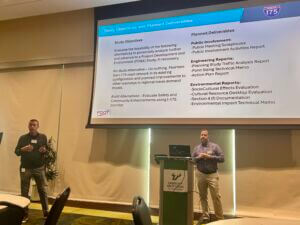I-175: Preserving & Enhancing Access While Reconnecting Communities

Position Statement
The St. Petersburg Area Chamber of Commerce understands that I-175 is being evaluated for possible modification or removal. The Chamber welcomes this study but believes changes to the existing structure, if any, must account for I-175’s importance to local businesses and hospitals and the potential growth St. Petersburg will experience in the future. The Chamber is open to considering changes to I-175 that promote economic growth and improve community connectivity, so long as they do not reduce I-175’s vehicular capacity or increase travel times and I-175 remains at a minimum a 4-lane spur route which connects I-275 to parts of downtown St. Petersburg.
Historical Context
Interstate 175 (I-175), a 1.3-mile spur constructed in the late 1970s, was designed to facilitate efficient access to downtown St. Petersburg, and was part of a broader initiative to enhance urban mobility by connecting Interstate 275 directly to downtown. This development aimed to support the growing demands of the city's core institutions, including medical centers and educational facilities. However, the placement of I-175 through the Gas Plant District inadvertently led to the displacement of numerous families and businesses, predominantly affecting African American residents. This construction not only disrupted established neighborhoods but also imposed lasting divisions within the urban landscape. Given this historical context, the Chamber recognizes that it is important to explore possible modifications to I-175 to further the goal of community reconnection.

St. Pete Chamber staff and several Chamber members recently attended the FDOT Project Advisory Kickoff Meeting
Current Utilization and Challenges
Presently, I-175 serves as a critical artery for daily commuters, providing access to key economic and healthcare hubs. For example, emergency responders rely on I-175 to gain quick access to and from local hospitals. I-175 also serves as one of two main access points from I-275 to the downtown core.
A 2019 study indicated that the highway operates below its capacity, which suggests modifications to the existing structure might be appropriate. However, the downtown core has experienced substantial growth since 2019, and anticipates further development to occur, particularly in the Gas Plant District. The 2019 study did not consider the development of the Gas Plant District, which must be taken into account when evaluating proposed modifications to I-175. Therefore, the Chamber supports conducting a new study that properly considers current and future development of the downtown core with specific consideration of traffic patterns and volume created by the future Historic Gas Plant Master Plan once solidified.
Initiatives for Reconnection
Several initiatives have been proposed to evaluate I-175:
• Federal Funding for Reconnection Projects: In January 2025, the city was awarded $1.3 million from the U.S. Department of Transportation's Reconnecting Communities Pilot Program. These funds are designated for planning and conceptual design efforts to address recommendations from the Downtown Mobility Study involving conversion of 8th Street and Dr. MLK, Jr. Street from one-way to two-way streets for improved access, safety, and connectivity between downtown and South St. Petersburg.
• I-175 Redevelopment and Reconnecting Communities Strategy: In collaboration with Forward Pinellas, the City of St. Petersburg is conducting a study focusing on land use, urban design, equity, and transportation. This community-driven effort aims to explore options for modifying or capping I-175 to enhance connectivity while preserving essential access.
Balancing Access and Community Reconnection
As discussions progress, it is essential to ensure that any modifications to I-175 preserve reliable access to downtown's commercial centers and medical facilities. The St. Petersburg Area Chamber of Commerce supports investment in infrastructure improvements that balance mobility, economic growth, and community needs. Factors to consider include:
Economic Vitality & Business Growth
- Downtown St. Petersburg is an economic engine for the region, housing key businesses, retail, restaurants, and entertainment venues that rely on accessible transportation for customers and employees.
- Disrupting access to the downtown core could negatively impact small businesses that depend on commuter and visitor traffic. Maintaining a well-connected roadway system supports economic stability and job creation.
- Reliable transportation access is a major factor for business investment. Any changes to I-175 must ensure continued ease of movement for business owners, workers, and consumers.Healthcare & Emergency Services
- Orlando Health, Bayfront Health, Johns Hopkins All Children’s Hospital, and other medical facilities rely on I-175 for emergency response and patient access. Modifying the highway must not create delays that impact healthcare outcomes.
- Employees and patients depend on efficient routes to reach medical appointments, outpatient procedures, and hospital visits. Any redesign must prioritize direct and time-sensitive access.Workforce & Commuter Accessibility
- Many downtown employees commute from surrounding areas, and a reduction in roadway capacity could create bottlenecks, increasing travel times and reducing productivity.
- Public transit enhancements must be integrated with road accessibility, ensuring options for those who rely on both personal vehicles and alternative transportation.
- Parking and last-mile connections should be a priority in any redesign to prevent congestion from shifting into downtown streets.Tourism & Hospitality
- St. Petersburg’s tourism economy thrives on accessibility. Hotels, museums, and waterfront attractions rely on visitors who expect smooth access to and from downtown.
- Special events, including concerts and sports games at Al Lang Stadium and the Mahaffey Theater, draw thousands of attendees who require efficient transportation routes.
Balanced Infrastructure Planning
- Reconnecting communities is a worthy goal, but it must be done strategically, ensuring the needs of businesses and essential services are not compromised.
- A data-driven approach should be taken to evaluate alternatives, with real traffic impact assessments before major changes are made.
- Engagement with the business community is critical to ensure that any adjustments to I-175 support economic sustainability while achieving broader urban planning goals.
Potential Options Moving Forward
The Chamber understands that the evaluation of I-175 is a hot button item that evokes strong emotions from each side of the debate. That is why the Chamber has spent several years studying the issue in detail, meeting with stakeholders, and evaluating the best possible outcomes for the business community. While the Chamber welcomes additional thoughts and ideas through this study, it maintains that any proposed modification must not reduce capacity or increase travel times to and from the downtown core.
Based on the extensive research done to date, the Chamber supports the following possibilities:
- Capping I-175 as a Solution: The Chamber supports studying the feasibility of capping sections of I- 175 to create public green space, similar to successful projects in other cities such as:
- Klyde Warren Park (Dallas, TX)
- Gateway Arch Park (St. Louis, MO)
- Frankie Pace Park (Pittsburgh, PA)
- South Loop Project (Kansas City, MO – under construction 2025).
- A Via-Duct System: The Chamber is open to exploring a via-duct system that modifies the existing structure of I-175 so that passing under the current structure is possible. However, this system must still provide access to local hospitals to ensure travel times for emergency situations are not impacted.
- No Build: The Chamber is not opposed to leaving I-175 in place and finding alternative measures to improve connectivity for all residents of St. Petersburg.
Stay informed by checking out the FDOT I-175 Action Plan and Project Details. Add your feedback by contributing to the FDOT Virtual Comment Tool.
Chamber members are invited to attend monthly Transportation Committee meetings on the 2nd Tuesday of the month. Click here for more information and to RSVP.

